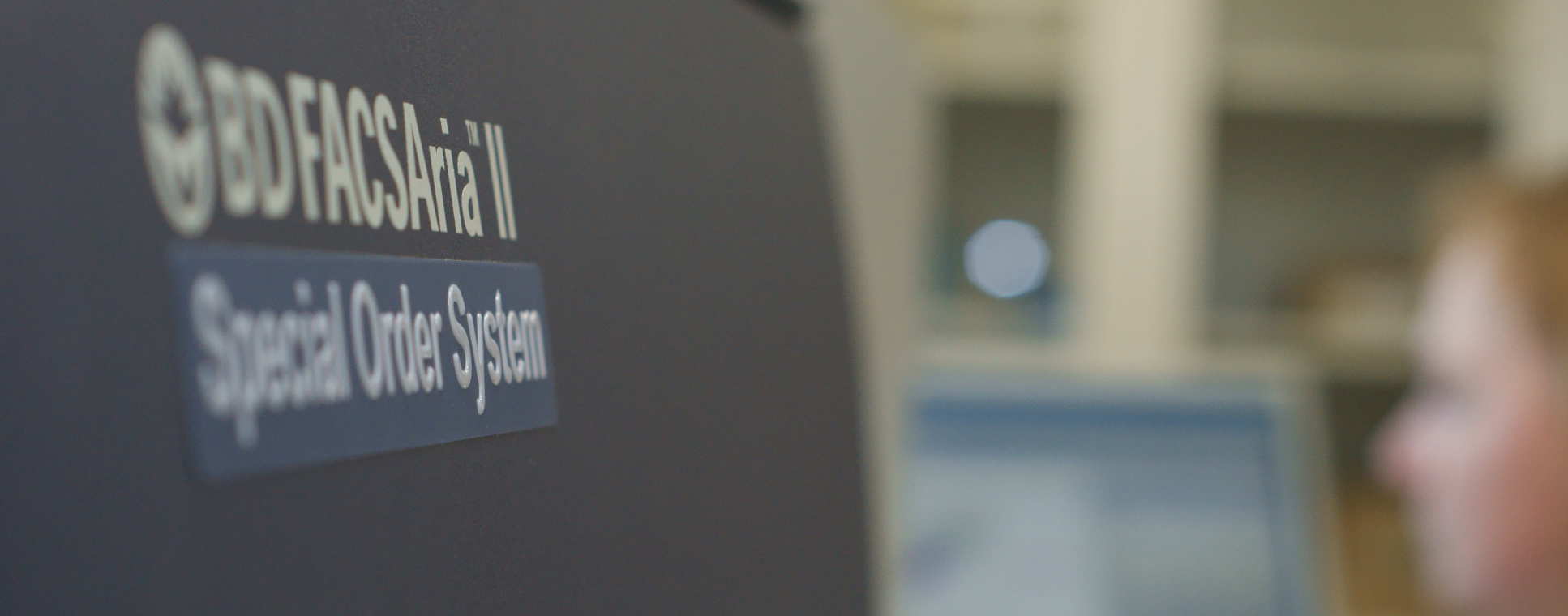Cell sorting

Fluorescence-activated cell sorting allows analysis and physical sorting of subpopulations from a mixture of cells.
Cells can be sorted into a variety of collection tubes (1.5mL and 2mL eppendorfs, 5mL FACS tubes, 15mL Falcon tubes) and plates (96 well, 384 well) containing collection buffer. If using tubes, polypropylene is preferable to polystyrene. If collecting into very small volumes in plates, for example for single cell RNAseq, please discuss with us in advance; the instruments might need additional calibration via colorimetric enzymatic assay and you may need to supply reagents.
Cell sorting guidelines
Read through the tabs below for further information:
Cell sorting
Which sorter should I book?
For Cat 2 sorting, importantly including primary human cells where the donor has not been screened for blood-borne viruses, you must book the BRC Aria II (3 laser system: violet, blue, red) located in the Commonwealth building.
For other samples we strongly encourage the use of the three Arias (AII/AIII/Fusion) located at ICTEM. These three can largely be used interchangeably, except:
- The AII lacks a yellow-green (561nm) laser, so is less able to detect certain fluorochromes such as mCherry and mTomato. Please ask us if you are unsure if your sample requires a YG laser.
- Only the Fusion has a UV (355nm) laser, required for fluorochromes such as Hoechst and the BUV range.
- The AIII and Fusion are preferable for plate sorts.
Whilst we will try to run your sample on the instrument of your choice, for operational reasons we may require that your booking is moved to an alternative sorter.
Cell preparation
A good buffer for both your pre-sort and collected sample is crucial for a successful sort.
Normal culture media is not an ideal sort buffer for two reasons: 1) its pH regulation fails outside of incubators where CO2 is high and 2) the calcium chloride present in most culture media is not compatible with the phosphate component of the cytometer sheath buffer, leading to precipitation of calcium phosphate crystals. Following the suggested sort buffer below (and modifications where relevant), will help maximize the recovery and viability of sorted cells.
BASIC SORT BUFFER
- 1x Phosphate Buffered Saline (PBS) Ca/Mg++ free
- 1 mM EDTA (useful)
- 25 mM HEPES pH 7.0 (optional)
- 1% Fetal Calf Serum (FCS) heat-inactivated
- Filter and store at 4°C or -20°C
Modifications
Sticky cells (e.g. activated T cells): Raise the concentration of EDTA to 5 mM, Use FCS that has been dialyzed against Ca/Mg++ free PBS. Activated cells be sticky and EDTA helps reduce cation-dependent cell-cell adhesion.
Adherent cells
In order to achieve good single cell preparation, one must start at the moment of detaching your cells from the plate. Typically trypsin (or other detachment buffer) is quenched with culture media or a PBS/FCS buffer – this is problematic because it reintroduces the cations that facilitate the cells reattaching to the plate or to each other. An alternative, therefore, is to use soybean trypsin inhibitor. Otherwise, cation-free FCS buffer should be used, and the level of EDTA increased.
High-percentage dead cells (e.g. samples prepared from frozen)
If there are a large number of dead cells in the sample it is likely there DNA released that will coat the cells and lead to clumping. Adding 10 µL.ml-1 DNAase to the sort buffer will reduce DNA-associated clumping.
FILTERING
Samples must be filtered through a 40um filter (BD Cat No. 340632 or Falcon Cat No 352340). Unfiltered samples cannot be run!
COLLECTION BUFFER
Your cells may have particular requirements, but in general FCS in an air buffered solution such as PBS or HEPES-buffered media is good for most cells. The concentration of FCS is usually 10% or higher – note that the final FCS concentration post-sort will depend on how many cells are collected and consequently how much the collection buffer is diluted. FCS should be put through a 0.45um filter to avoid particulates interfering with any sort check for purity.
Though every effort is made to reduce the risk of contamination we advise in the initial culture you add not only penicillin and streptomycin, but also 5 µg.ml-1 gentamycin, as this is more heat stable.
How long should I book for?
For a ‘new’ sample this can be hard to predict as it will depend not on the number of cells you bring, but also on the cell type (larger cells are run more slowly) and the amount of debris in the sample – note that speeds advertised for cell sorters are given in events, not cells, per second, so if 90% of what the cytometer ‘sees’ in a sample is debris (dying cells, cell fragments, particulates) it will take much longer to run than one which is 90% of what it sees are cells. For this reason, the sort rate is often only apparent when we start sorting the cells.
There is also a ‘sort compromise’, which is a balance between the yield (number of cells recovered) and the time taken to sort – for a given sample, the faster it is run, the more cells are discarded by the cytometer in keeping the purity high. Where on this balance we run your sample is best discussed when you come.
Nonetheless, if you would like a rough estimate of how much time to book, please email us the rough number of cells you want to sort (ie the input number of cells for the sorter), the cell type and if possible the approximate expected percentage of the subpopulation that you want to collect (ie the output). Note that the latter is more important if the target population is small.
Finally, for particularly delicate cells it can be best to run them slowly – please let us know if you think this to be the case.
Controls
Whenever possible, please bring both negative and single-stained positive controls, in addition to your sample.
How to book the sorters
Please see our Registration and pricing page for details.


